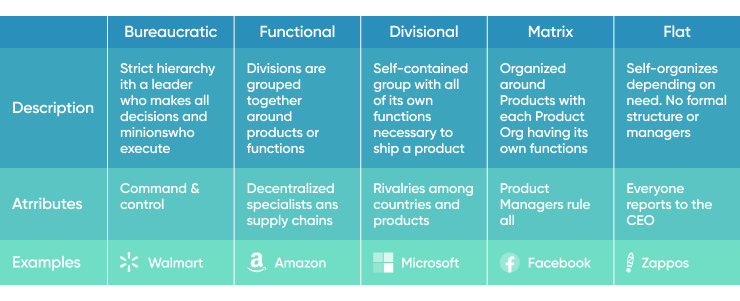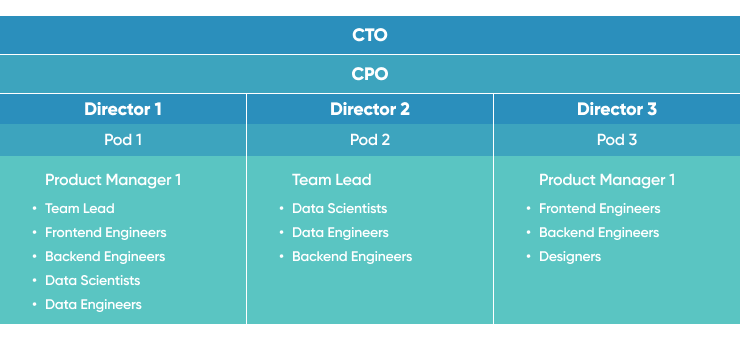When setting up an organizational structure for a technology startup, several questions arise such as which type of structure to start with, when to transition to accommodate growth..
In this article, we demystified the CTO Organizational Structure, unveiled its pros and cons, and revealed the roles and the impact a CTO makes all through the startup’s growth stages.
Types of Organizational Structures

Perhaps you have picked an organizational structure for your startup. Let's guess!
You drew something like a pyramid with C-level executives at the top and lines stretching down to their subordinates and to the last level where you have the staff-level workers. This is one of the most common organizational structures both small and companies use. It is called the hierarchical structure
The truth is not every startup maximizes its potentiality by adopting a hierarchical structure. And at the same time, there is no perfect structure.
Let’s explore the common org structures and why you should consider any of them:
Hierarchical org structure
This is the pyramid-shape chart we assumed you drew while thinking about an option. It's the most common with the chain of command following a top-down direction. You have the company founders at the top, followed by the supervisors and then the employees.
Below are the pros and cons
Pros
- It clarifies the authority level and responsibilities.
- It unveils who every employee reports to and who coordinates actions relating to each project.
- It guides and inspires team members about career paths and the possible chances of promotion.
- It helps every member to stand out in their specialty.
Cons
- Bureaucracy can dampen innovation and crucial changes.
- Team members can act in the interest of their sub-unit instead of the organization as a whole.
- Subordinates or lower-level employees may find it difficult to own the project and may lock off instead of freely expressing their ideas.
Functional Org structure
It shares a resemblance with the hierarchical structure as positions are organized beginning from the highest levels of assignment from the top to the last employee at the base. The only slight difference is that each position is based on the skills and functions expected of the employees in the company. Every department or unit is managed independently.
Pros
- Employees focus on their roles and responsibilities.
- It promotes specialization
- Every team and department in the organization feels self-determined.
- It is scalable.
Cons
- It can cause silos in the organizations
- It hinders communications between departments
- It creates complexity in strategies and processes for different products and markets in the organization.
Divisional
A divisional org structure is a type where each of the divisions controls its resources and operates like a stand-alone company. Each division has its sales team, marketing team, IT team, etc., and does not necessarily have to report to a central executive. Most large organizations adopt this structure based on product, market, and geography.
Pros
- It enables big companies to remain flexible.
- It allows prompt response to customer needs and industry and trend changes.
- It enhances autonomy, independence, and a unique approach.
Cons
- It can confuse communication between divisions and headquarter
- Duplication of resources (both human and capital)
- It can lead to undue competition among divisions.
Matrix
A matrix org structure takes the shape of a grid with cross-functional teams formed for special projects. For instance, an engineer can also double as a temporary worker under a project manager. The matrix chart reflects the roles and who reports to who.
Pros
- Supervisors can onboard the team based on the project needs.
- Team members maximize their skills and potentialities aside from their main roles.
Cons
- It can cause conflicts between project managers and department managers.
- It can change more often than necessary compared to other structures.
- It ensures you assess your business needs and align them with any of the CTO organization structures as you grow.
Flat org Structure
This org structure is suitable for startups with few levels between superordinates (the upper-level managers) and subordinates (staff-level employees). Most startups love this structure as it reduces time spent on supervision and ensures every employee is involved.
Pros
- Saddles employees with more functions and tasks.
- Enhances open communication.
Cons
- It can cause confusion as employees are clueless about who exactly to report to.
- Can become dysfunctional as the startup scales.
The Role of the CTO
The core mission of a CTO is clear- to ensure the company's technology maximizes its business strategy. Regardless of the company size, age, or financial capability, this role is pivotal and the most crucial for a CTO.
We might gain a better understanding of how these CTO roles evolve if we assess the different stages a tech startup goes through in its business cycle. Also, check article CTO job description startup.
Business Idea Phase

From a little acorn, an oak tree grows; the same with every technology startup. At the ideation stage, a company may not even exist. Founders gather to brainstorm, draw issue trees, gather ideas, and develop a viable business plan. A CTO who is versatile in his or her repertoire in these brainstorming can be the game-changer as he can validate the business feasibility and suggests technical solutions to launch a software product.
The Early Stage

If the investors buy into the idea, the team proceeds to build a software product. At this point, the CTO is more or less the first and the only developer who coordinates the development of a minimum viable product(MVP) within a shorter time frame.
He or she selects a technology stack, designs the application architecture, and establishes a scalable cloud-based infrastructure(coupled with selecting a cloud services vendor. Check our CTO Services for Startups for more details.
These roles require relevant experience, strong coding skills, and the ability to align with an agile software development workflow. While a software development startup might hire a developer, a CTO still codes at this early stage of the business.
Reaching Product-market fit

As your tech startup continues to gain traction, the focus shifts to optimizing its software solution and enhancing its functionality, and improving the user experience to increase the customer base.
To expedite the software development, most startups will onboard more developers.
The role of a CTO is also crucial and dynamic here as he or she takes some management-related responsibilities. Not only that, he or she has to ensure the feature deployment pipeline is streamlined to ensure all developers are productive. Other responsibilities include ensuring high uptime and security of the application and provide cost-effective and scalable cloud infrastructure.
A CTO manages developers as the team grows, supervises hiring and onboarding, and enforces a software development culture. This cultural aspect is highly crucial as a coding culture ensures all developers are working in tandem with uniform standards and best coding practices such as writing quality code and achieving optimal productivity.
Growth Stage
At this stage, your technology startup has become successful and a large organization with several employees. As the CTO, you lead a large team of software developers and establish a coding culture and a streamlined workflow. Your core responsibility at this stage is purely management. Peradventure your company wants to launch a new product, you as the CTO needs to set up a team and coordinate other development teams that would be collaborating on the project.
Coupled with that, you would need to build a vision for the software product, keep yourself abreast of the latest trends in your industry and implement the ones relevant to the product you are working on. That being said, a CTO needs an in-depth understanding of competitors and business processes.
In a nutshell, the CTO leverages the best and relevant technology to ensure the startup remains competitive.
Conclusion
As your startup scale and you add more developers to your team, creating a growth plan becomes important. Growth has to be properly managed down the line so it does not culminate into low morale, redundancy, and low productivity.
For instance, when you were a small team, it was easier to pass communication down the line, ratify on a major decision and get every member of a team to buy in easily.
If you feel the growth you are experiencing demands a change in organizational structure, don't hesitate to make this move as the CTO.
It is imperative to state here that no perfect organizational structure exists. As your company evolves, you should also tweak your structure and business processes so you can maximize your team of software developers, improve their happiness and productivity.

![CTO Organizational Structure [by Startup Growth Stage]](/.netlify/images?url=_astro%2Fcto-organizational-structure.Cm8aXUEe.png)




